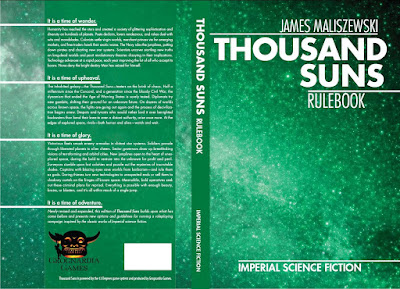This just arrived for me from DriveThruRPG today — the Thousand Suns rulebook by Jame Maliszewski. The POD format is (I think) digest-sized, and softcover — I believe you can also order it as a hardcover, but that would just be the softcover glued into a case binding. It might be a little more hard-wearing, maybe.
It's intended for fairly pulpish science fiction / space opera gaming. There is nothing particularly startling about the system; it's a pretty standard target-number skills-based game, using modified 2d12 rolls as the base mechanism. It is built to be about as simple as it's possible to be though, which is all to the good.
It includes, or is built around, a fairly nebulous milieu of Space Empires for players to rampage through. There are a couple of example alien races detailed, as well as a couple of genetically modified human variants (plus standard humans, or Terrans as they're called in the book) which give players enough to be going on with, and which provide templates for GMs to build their own aliens and things. Likewise, there are examples of spaceships and what-not, again enough to jump right in, and to provide guidance for building one's own.
I haven't yet read it through thoroughly, but it seems to me to be a decent enough space opera game, and simple enough to be able to run off the cuff without too much trouble.
There's a little supplementary material available — a book on starships, a star sector description and accompanying adventure, and there's the first issue of an occasional magazine too, called Imperio with an excellent cover by Russ Nicholson and the usual sort of bits and pieces you'd expect in a RPG system mag. Hopefully more will follow, but it's not really necessary; it would be a pretty simple matter for your average GM to create or adapt the material they want for this system.
I'm looking forward to trying it out.













